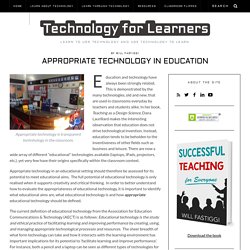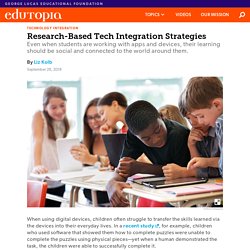

Tips & Resources. Tech & Learning: Ideas and Tools for EdTech Innovators. Education Technology Tools for Teachers. Massive Open Online Courses make it possible for students of all ages to access high-quality coursework at no cost. Colleges and universities across the country publish video lectures, podcasts, reading lists, practice exams and more for anyone who wants to learn about a particular subject and/or experience what it’s like to take a college class. Over the last decade, organizations such as Coursera and Khan Academy have taken MOOCs one step further by creating or aggregating thousands of free courses in areas ranging from early American history and civics to trigonometry and multivariable calculus.
Khan Academy is a non-profit educational website created by educator Salman Khan in 2006. Khan, a graduate of MIT and Harvard Business School wanted to provide a free world-class education for anyone anywhere. Students and teachers have access to a personalized learning dashboard which allows them to connect to thousands of educational resources. Algebra (University of California, Irvine) Welcome to Teaching with Technology! - Teaching with Technology.
Appropriate Technology in Education. Appropriate technology is transparent technhology in the classroom.

Education and technology have always been strongly related. This is demonstrated by the many technologies, old and new, that are used in classrooms everyday by teachers and students alike. In her book, Teaching as a Design Science, Dana Laurillard makes the interesting observation that education does not drive technological invention. Instead, education tends to be beholden to the inventiveness of other fields such as business and leisure.
There are now a wide array of different “educational” technologies available (laptops, iPads, projectors, etc.), yet very few have their origins specifically within the classroom context. Appropriate technology in an educational setting should therefore be assessed for its potential to meet educational aims. Traditionally, the concept of appropriate technology has been discussed with respect to economic development. Appropriate technology can take the form of many different tools. 25 Easy Ways to Use Technology in the Classroom. Although many technology-based teaching methods and resources effectively engage students and build their skills, many educators encounter difficulties when using technology in the classroom.
Maybe a specific platform is too hard to introduce. Or maybe it won’t run on your devices. Despite the challenges, you likely want to enjoy the benefits that education technology can deliver. Using the ones that best apply to you and your students, and keeping the condensed list on your desk for quick reference, consider these 25 easy ways to use technology in the classroom: Offering a Unique Learning Experience 1. An ambitious way to use technology in the classroom, you can introduce a game-based learning platform. Most are designed to engage students, enlivening difficult topics and subjects. Prodigy is one, providing math content up to the 8th grade level that’s aligned with curricula across Canada, Australia, England and the United States.
Research-Based Tech Integration Strategies. When using digital devices, children often struggle to transfer the skills learned via the devices into their everyday lives.

In a recent study, for example, children who used software that showed them how to complete puzzles were unable to complete the puzzles using physical pieces—yet when a human demonstrated the task, the children were able to successfully complete it. How does this research inform my classroom practice with technology? Instead of relying on the tutorials that come with the educational software we use, I demonstrate myself how to use it, and I create my own video tutorials because my students are more likely to take up the skill when they hear my familiar voice and see me demonstrating the features.
Free Technology for Teachers. 8 Strategies for Using Technology in the 21st Century Classroom. We’ve all seen the black and white images of the one-room schoolhouse. Students sit in perfect rows that face a teacher who’s writing on a chalkboard. Up until the last decade, our classrooms haven’t drastically differed from those 100-year-old images. We are so fortunate to be living and teaching in a time of rapid educational change. Instead of personal student chalkboards, a number of students now have access to electronic tablets.
Many teachers can now use Smartboards instead of dry-erase boards. Although these changes are exciting, using technology in the classroom can seem overwhelming when you have multiple objectives to achieve each day and 30 – 35 students to engage simultaneously. 1. Just as any well-managed classroom, set up is essential. Establish, display, teach and repeat your classroom rules and procedures when using devices. Lastly, have a system for student logins. 2. 3. The number one mistake I’ve seen in classrooms using devices is the order of process. How to Make Smart Choices About Tech for Your Course.